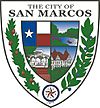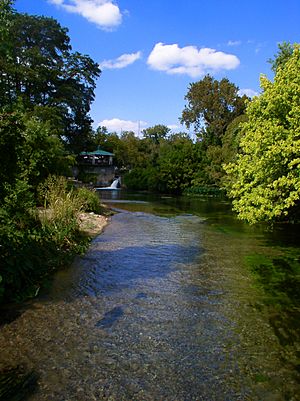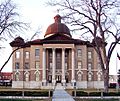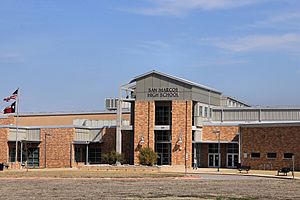San Marcos, Texas facts for kids
Quick facts for kids
San Marcos, Texas
|
||
|---|---|---|

Hays County Courthouse Historic District
|
||
|
||
| Nickname(s):
San Marvelous
|
||
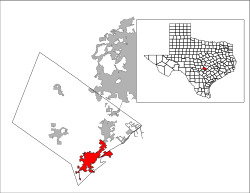 |
||
| Country | ||
| State | ||
| Counties | Hays, Caldwell, Guadalupe | |
| Government | ||
| • Type | Council-Manager | |
| Area | ||
| • Total | 35.71 sq mi (92.50 km2) | |
| • Land | 35.59 sq mi (92.18 km2) | |
| • Water | 0.12 sq mi (0.32 km2) | |
| Elevation | 617 ft (188 m) | |
| Population
(2010)
|
||
| • Total | 44,894 | |
| • Estimate
(2019)
|
64,776 | |
| • Density | 1,820.01/sq mi (702.70/km2) | |
| Demonym(s) | San Marcoan, San Martian | |
| Time zone | UTC-6 (CST) | |
| • Summer (DST) | UTC-5 (CDT) | |
| ZIP codes |
78666–78667
|
|
| Area code(s) | 512 and 737 | |
| FIPS code | 48-65600 | |
| GNIS feature ID | 1375971 | |
San Marcos ( SAN-_-MAR-kəs) is a city and the county seat of Hays County, Texas, United States. The city's limits extend into Caldwell and Guadalupe counties, as well. San Marcos is within the Austin–Round Rock metropolitan area and on the Interstate 35 corridor between Austin and San Antonio. Its population was 44,894 at the 2010 census and 67,553 at the 2020 census. Founded on the banks of the San Marcos River, the area is thought to be among the oldest continuously inhabited sites in the Americas. San Marcos is home to Texas State University and the Meadows Center for Water and the Environment.
In 2010, San Marcos was listed in Business Week's fourth annual survey of the "Best Places to Raise your Kids". In 2013 and 2014, the United States Census Bureau named it the fastest-growing city in the United States. In December 2013, it was named number nine on Business Insider's list of the "10 Most Exciting Small Cities In America".
Contents
Geography
San Marcos is in Central Texas. It is 30 miles (48 km) southwest of Austin and 51 miles (82 km) northeast of San Antonio. According to the United States Census Bureau, in 2010, the city had a total area of 30.3 square miles (78.6 km2), of which 30.2 square miles (78.3 km2) was land and 0.1 square miles (0.3 km2), or 0.44%, was covered by water. Interstate 35 is the main highway through the city, with access from Exits 199 through 208. The city is situated on the Balcones Fault, the boundary between the Hill Country to the west and the Coastal Plains to the east. Along the fault, many springs emerge, such as San Marcos Springs, which forms Spring Lake and is the source of the San Marcos River. The eastern part of the city is blackland prairie. The western part consists of forested or grassy rolling hills, often marked with cacti.
The San Marcos River and the Blanco River, part of the Guadalupe watershed, flow through the city, along with Cottonwood Creek, Purgatory Creek, Sink Creek, and Willow Springs Creek.
Climate
The climate in this area is characterized by hot, humid summers and generally mild to cool winters, with some winter frost at night. Annual precipitation is about 34 inches (864 mm), almost all is rain (winter snow or ice is very rare). According to the Köppen climate classification system, San Marcos has a humid subtropical climate, Cfa on climate maps.
Transportation
- Capital Area Rural Transportation System
- San Marcos Municipal Airport
- San Marcos Station is served by Amtrak's Texas Eagle
Parks and recreation
The San Marcos and Blanco Rivers flow through the city, along with Cottonwood Creek, Purgatory Creek, Sink Creek, and Willow Springs Creek. Each of these rivers and creeks has parks or nature preserves with hiking trails along it.
The San Marcos River rises from the San Marcos Springs. The springs are home to several threatened or endangered species, including the Texas blind salamander, fountain darter, San Marcos gambusia, and Texas wild rice. The river begins at San Marcos Springs, rising from the Edwards Aquifer into Spring Lake. The upper river flows through Texas State University and San Marcos and is a popular recreational area. It is joined by the Blanco River after four miles, passes through Luling and near Gonzales, and flows into the Guadalupe River after 75 miles (121 km). This course is the first leg of the Texas Water Safari.
Arts and culture
In 2010, San Marcos was listed in Business Week magazine's fourth annual survey of the "Best Places to Raise your Kids." In 2013 and 2014, the United States Census Bureau named San Marcos the fastest-growing city in the United States. In December 2013, San Marcos was named #9 on the Business Insider list of the "10 Most Exciting Small Cities In America."
The river is a popular recreational area and is frequented by residents and tourists for tubing, canoeing, swimming, and fishing. The Texas Water Safari] starts in San Marcos on the first Saturday in June each year. Due in part to its natural beauty, the city was nicknamed "San Marvelous". The City of San Marcos references the nickname in its "Keep San Marcos Beautiful" campaign.
The town center (referred to locally as "the square") was laid out in 1851 and is listed in the National Register of Historic Places. The Hays County Courthouse, which sits in the center, was built in 1908. The downtown area surrounding the courthouse is home to many of the city's bars, restaurants, boutiques, and music venues, making it a top entertainment destination. The Marc, directly across the street from the courthouse, hosted the 2011, 2012, and 2013 Lone Star Music Awards.
In addition to the historic downtown, San Marcos has five residential historic districts. The city also boasts of at least 40 homes and buildings on the National Register of Historic Places. National Register of Historic Places listings in Hays County, Texas.
Local media include the San Marcos Daily Record, the San Marcos Mercury, and The University Star.
Public art
The City of San Marcos and the San Marcos Arts Commission broke ground in January 2013 on a commemorative sculpture that will sit at the intersection of LBJ Drive and MLK Drive. Designed by Aaron P. Hussey, the sculpture depicts Johnson and King conversing in the Oval Office. The sculpture was officially unveiled on Martin Luther King, Jr. Day in 2014.
The downtown area has become home to several graffiti-style murals, including designs depicting Jeff Bridges' character The Dude from The Big Lebowski.
In 2016, the San Marcos Arts Commission announced a citywide art installation project that would erect 10 mermaid statues throughout the city. Mermaids have been part of San Marcos culture since the mid-1900s, when the former Aquarena Springs amusement park began underwater performances by women dressed as mermaids. Each mermaid statue will be 7 ft tall and mounted on a limestone slab to make the final height closer 9 ft. While the sculptures will be identical, each will be decorated by a different artist.
Music
For more than 20 years, the San Marcos Performing Arts Commission and the San Marcos Parks and Recreation Department have hosted the Summer in the Park concert series with live music at an outdoor venue every Thursday night from June to August.
The Cheatham Street Warehouse helped launch the careers of George Strait, Stevie Ray Vaughan, Randy Rogers, Todd Snider, James McMurtry and Terri Hendrix, among others. The Cheatham Street Foundation continues work to preserve Texas music traditions and has offered seminars on the business end of the music business.
Contributing to the music scene in San Marcos, Texas State University hosts the Hill Country Jazz Festival and Eddie Durham Celebration annually.
KTSW, the university's radio station, also holds an annual festival called MR Fest. "MR" stands for "My Radio" but is pronounced "mister".
In 2012, local entrepreneurs began hosting an ongoing outdoor concert series called Foodstock (a play on Woodstock) to benefit the Hays County Food Bank.
Film
Many television shows and movies have filmed in San Marcos, including Friday Night Lights, Everybody Wants Some!!, Boyhood, American Crime, That's What I'm Talking About, Piranha, The Ringer, Courage Under Fire, The New Guy, The Faculty, Idiocracy, The Getaway, The War at Home, Little Boy Blue, Flesh and Bone, Race With the Devil, The Tree of Life, Tiramisu For Two, and Vikings.
History
Archeologists have found evidence at the San Marcos River associated with the Clovis culture, which suggests that the river has been the site of human habitation for more than 10,000 years. The San Marcos Springs are the third-largest collection of springs in Texas. Never in recorded history has the river run dry.
In 1689, Spaniard Alonso de Leon led an expedition from Mexico to explore Texas and establish missions and presidios in the region. De Leon's party helped blaze the Camino Real (later known as the Old San Antonio Road), which followed present-day Hunter Road, Hopkins Street, and Aquarena Springs Drive (the route later shifted four miles to the south; it is now followed by County Road 266, known locally as Old Bastrop Highway). De Leon's party reached the river on April 25, the feast day of St. Mark the Evangelist; the river was thus named the San Marcos.
In January 1808, a small group of Mexican families settled at the Old Bastrop Highway crossing of the river, and named the settlement Villa de San Marcos de Neve. The settlers were plagued by floods and Indian raids, and the settlement was abandoned in 1812.
In November 1846, the first Anglos settled in the vicinity of the San Marcos Springs. The Texas Legislature organized Hays County on March 1, 1848, and designated San Marcos as the county seat. In 1851, a town center was laid out about a mile southwest of the headwaters of the river. The town became a center for ginning and milling local agricultural products. The town's most notable founder and early settler was Gen. Edward Burleson, a hero of the Texas Revolution and former vice president of the Republic of Texas. Burleson built a dam on the upper reaches of the river in 1849. The dam powered several mills, including one within present-day Sewell Park.
In the decade following the arrival of the International-Great Northern Railroad in 1881, cattle and cotton provided the basis for the growth of San Marcos as a center for commerce and transportation.
In 1866, the Coronal Institute was established as an early private high school. In 1899, Southwest Texas State Normal School (now known as Texas State University) was established as a teacher's college to meet demand for public school teachers in Texas. In 1907, the San Marcos Baptist Academy was established, furthering education as an important industry for the town. The demands of World War II forced the town's industry to diversify, and with the emergence of a manufacturing and light industrial sector, the town began to experience growth.
In the late 1940s, former Hollywood director Shadrack Graham produced a documentary about daily life in San Marcos as part of his “Our Home Town” series of films that encouraged commerce and civic activity in small communities. The film highlights several local businesses from the era, including Smith's Flowers, Waldrin's Cleaners, Lack's Furniture, and the Palace Movie Theater.
Gary Air Force Base, just east of town, was opened in 1942 as San Marcos Army Air Field, renamed San Marcos Air Force Base in 1947, and renamed finally in 1953 in honor of Lieutenant Arthur Edward Gary, killed at Clark Field in the Philippines on December 7, 1941, the first San Martian to die in World War II. During the war, the base trained over 10,000 navigators, and in the following years was the largest center of Air Force and Army helicopter training for pilots and mechanics in the United States, with 21 squadrons and 4800 personnel stationed there. The base was handed over to the Army in 1956, renamed Camp Gary, and was closed in 1963. Subsequently, part of the base was taken over by the city for use as San Marcos Airport, while another part was reopened in 1966 as the Gary Job Corps Center.
In the 1960s, with the establishment of Aquarena Springs The remarkable growth explosion of Austin further allowed San Marcos to prosper.
By 1973, San Marcos and Hays County were included by the U. S. Census Bureau in the Austin Metropolitan Statistical Area. By that year, the city's population had grown to 25,000 citizens, along with an additional Southwest Texas State University student body of 20,000.
By 1990, the city's population had grown to 28,743, by 2000, it reached 34,733, and by 2010, it was 44,894. A report released by the U.S. Census Bureau in May, 2013, stated that San Marcos had the highest rate of growth among all U.S. cities and towns with at least 50,000 people. Its population rose 6.9% between 2011 and 2012.
Demographics
| Historical population | |||
|---|---|---|---|
| Census | Pop. | %± | |
| 1870 | 741 | — | |
| 1880 | 1,232 | 66.3% | |
| 1890 | 2,335 | 89.5% | |
| 1900 | 2,292 | −1.8% | |
| 1910 | 4,071 | 77.6% | |
| 1920 | 4,527 | 11.2% | |
| 1930 | 5,134 | 13.4% | |
| 1940 | 6,006 | 17.0% | |
| 1950 | 9,980 | 66.2% | |
| 1960 | 12,713 | 27.4% | |
| 1970 | 18,860 | 48.4% | |
| 1980 | 23,420 | 24.2% | |
| 1990 | 28,738 | 22.7% | |
| 2000 | 34,733 | 20.9% | |
| 2010 | 44,894 | 29.3% | |
| 2020 | 67,553 | 50.5% | |
| U.S. Decennial Census | |||
As of the census of 2010, the population was 44,894 people in the city. In 2000, 34,733 people, 12,660 households, and 5,380 families resided in the city. The population density was 1,907.5 people per square mile, (736.4/km2) in 2000. The 13,340 housing units averaged 732.6 per square mile (282.8/km2). The racial makeup of the city was 72.55% White, 5.53% African American, 0.65% Native American, 1.23% Asian, 0.11% Pacific Islander, 17.03% from other races, and 2.90% from two or more races. Hispanics or Latinos of any race were 36.50% of the population.
Of the 12,660 households, 19.2% had children under the age of 18 living with them, 27.9% were married couples living together, 10.1% had a female householder with no husband present, and 57.5% were not families. About 31.0% of all households were made up of individuals, and 5.7% had someone living alone who was 65 years of age or older. The average household size was 2.31 and the average family size was 3.08.
In the city, the population was distributed as 15.4% under the age of 18, 41.9% from 18 to 24, 24.8% from 25 to 44, 10.7% from 45 to 64, and 7.2% who were 65 years of age or older. The median age was 23 years. For every 100 females, there were 96.8 males. For every 100 females age 18 and over, there were 95.4 males.
The median income for a household in the city was $25,809, and for a family was $37,113. Males had a median income of $25,400 versus $22,953 for females. The per capita income for the city was $13,468. About 13.8% of families and 28.5% of the population were below the poverty line, including 22.1% of those under age 18 and 15.1% of those age 65 or over.
Places of interest
- Alkek Library
- Bobcat Ballpark
- Bobcat Stadium
- Farmers Union Gin Company
- First United Methodist Church
- Fort Street Presbyterian Church
- Freeman Ranch
- Meadows Center for Water and the Environment
- Old Main
- Rio Vista Dam
- San Marcos Mill Tract
- San Marcos Outlet Malls
- Texas State University
- Sewell Park
- Strahan Coliseum
- Wonder Cave
Gallery
Economy
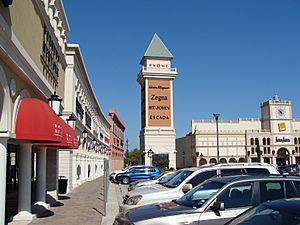
San Marcos' central location along IH-35 and strong infrastructure makes it ideal for industry. It includes business incentives, a high quality of life, regional airports and proximity to major international airports, access to major roadways such as IH-35, SH-130, US-183, and IH-10, networking opportunities and support for small businesses and entrepreneurs, a healthy tax structure, and a diverse and talented workforce.
Along with its easy access to air travel, San Marcos has ready access to several freight routes and IH-35 and IH-10, which run north/south and east/west, respectively, through the region. The access points of the area provide an easy route to major cities in Texas such as Austin, San Antonio, Dallas, and Houston.
The region has several institutions of higher education that provide a continual source of talent for the region's workforce. These institutions include the fourth-largest university in the state, Texas State University; as well as Gary Job Corps, an education and career technical training program.
The area's quality of life is highlighted by the San Marcos River, which is naturally fed by the San Marcos Springs. Many other lakes and rivers dot the local landscape, and the region's location within the Texas Hill Country provides easy access to the many outdoor amenities. In June 2006, The View named the San Marcos Outlet Malls as the third-best place to shop in the world. About 14 million people visit them annually.
Sports
Many residents of San Marcos support the athletic programs of the Texas State University known as the Texas State Bobcats. The football program won the NCAA Division II National Championships in 1982 and 1983 and now competes in the NCAA Division I (FBS) Sun Belt Conference. The Texas State Bobcats play home games in Bobcat Stadium, seating over 33,000 fans. Basketball and Volleyball games are played at Strahan Arena. Baseball games are played at Bobcat Ballpark.
Education
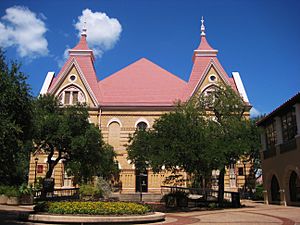
San Marcos is home to Texas State University, a multi-disciplinary public research university that was established in 1899.
For primary and secondary education, San Marcos is served by the San Marcos Consolidated Independent School District. San Marcos High School is the district's sole high school. San Marcos Academy, a private high school, is in the city. Doris Miller Middle School and Owen Goodnight Middle School are the two middle schools located in San Marcos. San Marcos is home to six elementary schools: Hernandez, Mendez, Crockett, Travis, Bowie, and DeZavala Elementary Schools. The city also houses a prekindergarten school, named Bonham Pre-K.
San Marcos is also served by the Hays Consolidated Independent School District, in which Blanco Vista Elementary School is located within the San Marcos city limits in the extreme northeastern part of the city.
The Forensic Anthropology Center at Texas State is one of the four extant body farms in the United States and the largest such forensics research facility in the world.
San Marcos is also home to Aquarena Center, the Meadows Center for Water and the Environment, the San Marcos National Fish Hatchery and Aquatic Resource Center, the A. E. Wood Texas Fish Hatchery, the San Marcos Nature Center, the Centro Cultural Hispano de San Marcos, and the Indigenous Cultures Institute.
Notable people
Images for kids
See also
 In Spanish: San Marcos (Texas) para niños
In Spanish: San Marcos (Texas) para niños


